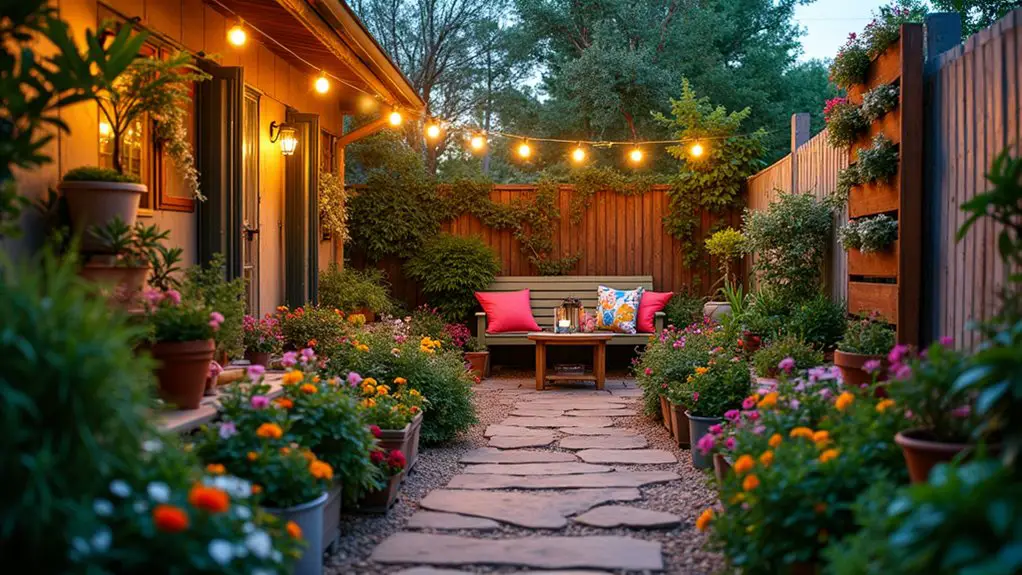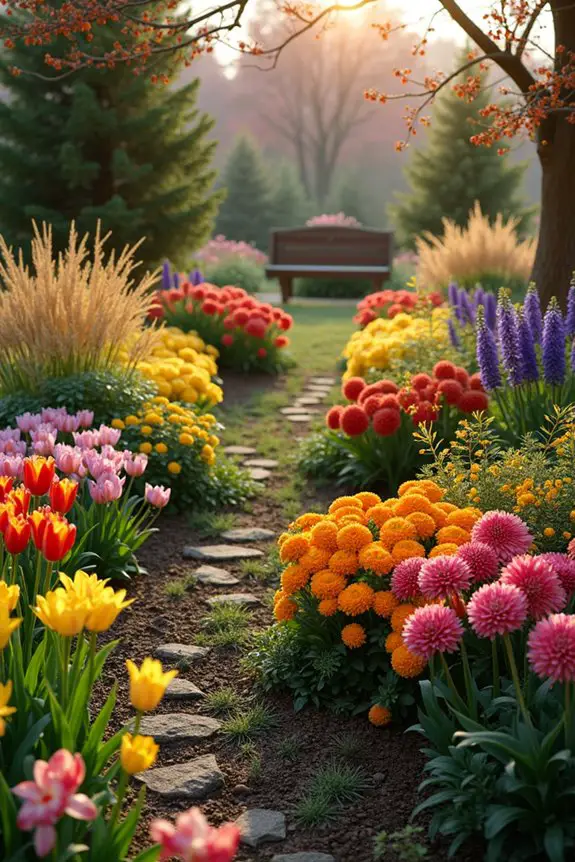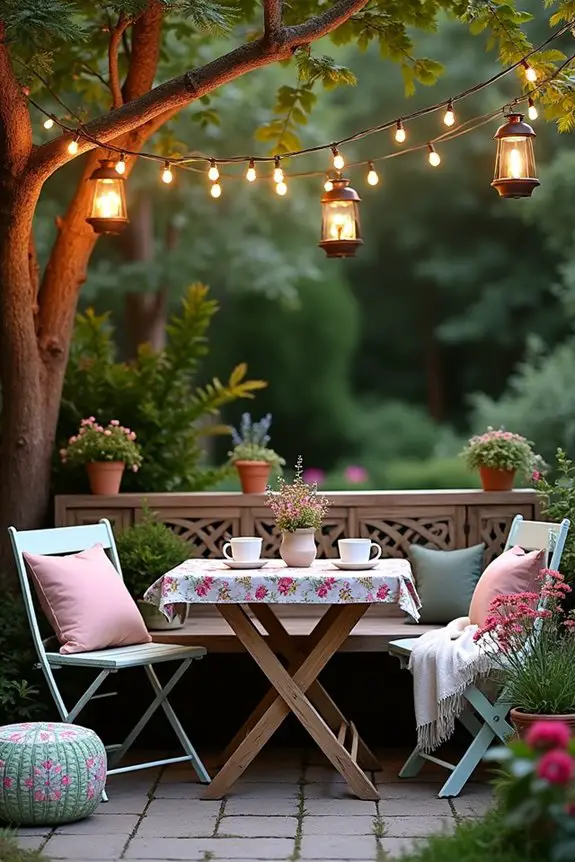Transforming a yard into an inviting space doesn’t have to come with a hefty price tag. There are many budget-friendly garden ideas that can enhance its appeal without sacrificing quality. Creative upcycling, simple DIY projects, and clever use of materials can lead to beautiful results. This exploration of practical options reveals how easy it is to bring a touch of personality to outdoor areas. New possibilities await those ready to improve their green spaces.
Create a DIY Vertical Garden With Recycled Materials
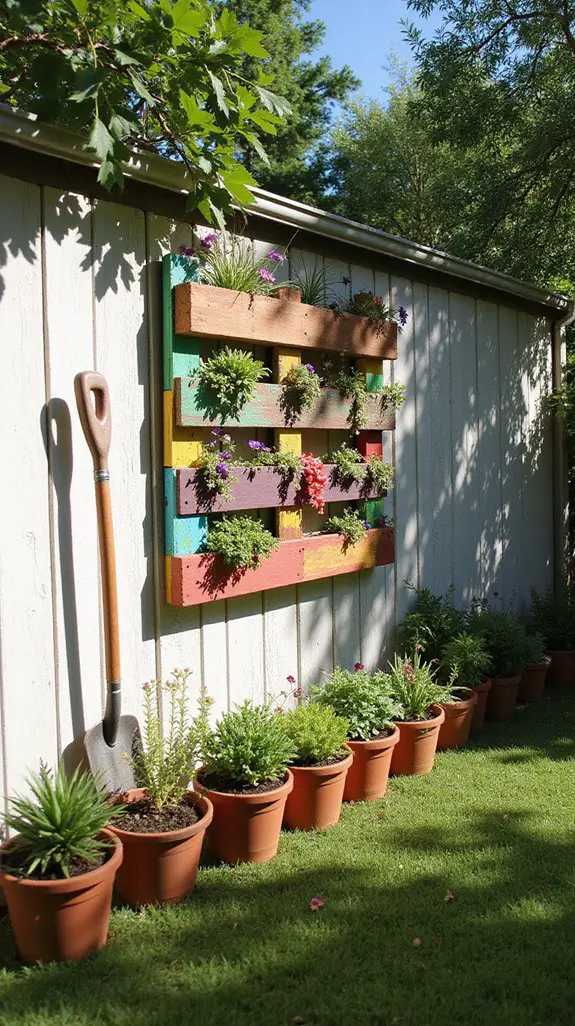
Although limited space can challenge gardening enthusiasts, creating a DIY vertical garden with recycled materials offers a practical solution. This approach not only maximizes available areas but also enhances the visual appeal of any outdoor space. A vertical garden can be complemented by incorporating a wooden garden table set, providing a charming and functional area for relaxation amongst the greenery.
By utilizing materials like old wooden crates, plastic bottles, and shoe organizers, gardeners can efficiently grow plants while promoting sustainability. This method reduces waste and is particularly suitable for budget-conscious individuals who seek creative gardening solutions. Incorporating elements such as anvil pruning shears can further enhance the maintenance and health of your vertical garden. Moreover, including biodegradable seed pots in your gardening setup can foster an eco-friendly environment by minimizing plastic usage.
A vertical garden provides an engaging way to showcase various plants, encouraging both resourcefulness and environmental responsibility in their garden design.
Use Old Pallets for a Rustic Planter
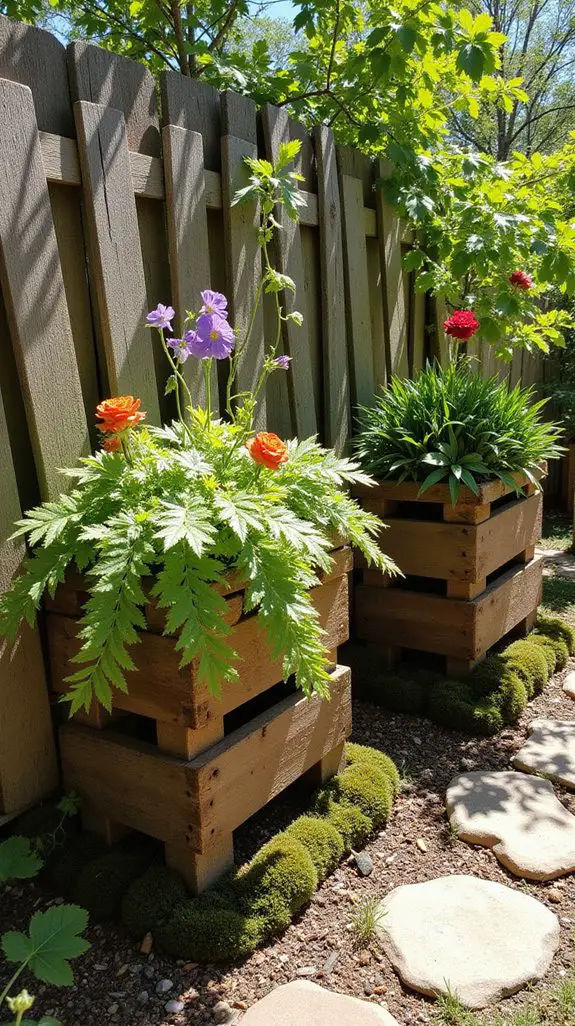
Building on the creativity of a DIY vertical garden, using old pallets for rustic planters presents another innovative way to enhance outdoor spaces. These versatile wooden structures can be easily transformed into charming planters for flowers, herbs, or vegetables. Prior to use, it is essential to sand and treat the wood to withstand weather conditions. Additionally, incorporating a plant humidity tray can help maintain the moisture levels needed for healthier plants. To further improve humidity levels, consider adding a pebble tray for humidity beneath your planters to create a microenvironment that promotes plant health. For precise gardening tasks, consider incorporating garden scissors snips to ensure clean and efficient cuts while tending to your plants. Moreover, repurposing materials like pallets not only saves costs but also aligns with the eco-friendly trend of using sustainable gardening practices.
Grow Herbs in Tin Cans or Mason Jars
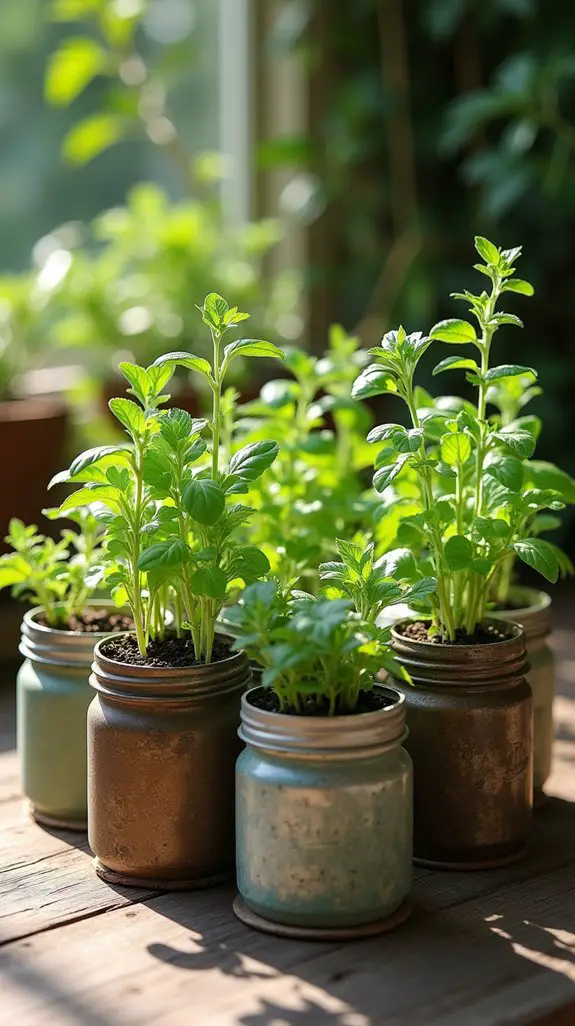
Herb gardening takes on a creative twist with the use of repurposed tin cans and mason jars, offering an affordable way to cultivate fresh herbs at home. These containers are not only budget-friendly but also add a touch of rustic charm to any space. Additionally, using a hand rake small garden can help you maintain the soil in these containers for optimal herb growth.
With minimal preparation, individuals can personalize their containers through painting or decorating, infusing their personality into the garden. Herbs like basil, cilantro, and mint thrive in these compact spaces, allowing for easy access during cooking. Additionally, using an herb seed variety pack ensures a diverse selection of flavor-enhancing herbs for your culinary adventures.
This method of gardening is particularly ideal for those with limited space, proving that anyone can enjoy homegrown flavors.
Start a Container Garden With Repurposed Buckets
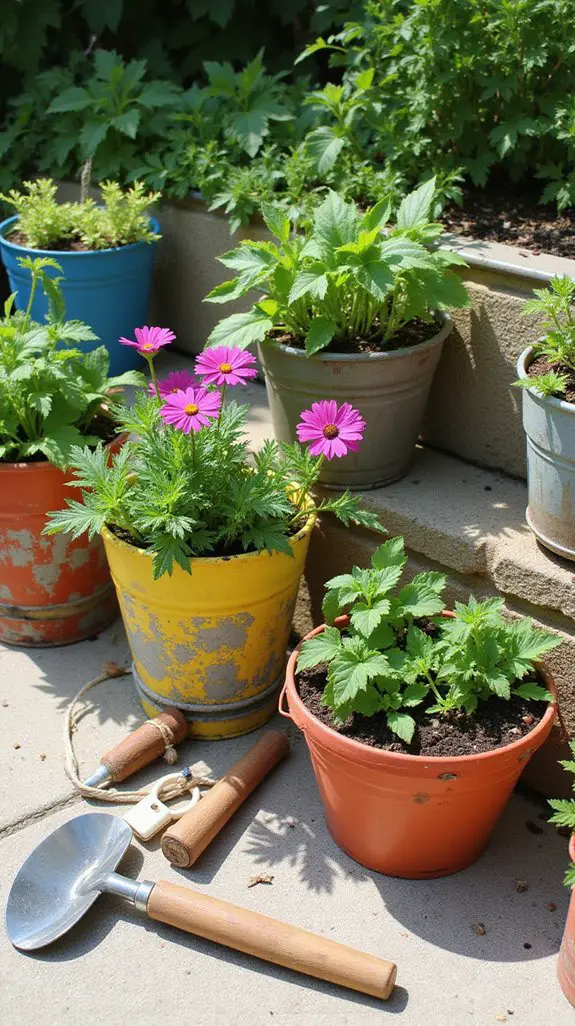
A container garden created using repurposed buckets offers a practical and cost-effective solution for urban dwellers and those with limited outdoor space. Buckets can be easily transformed into durable planters by drilling drainage holes and filling them with soil. This versatile option accommodates a wide variety of plants, including vegetables, herbs, and flowers. For those looking to optimize lighting for their indoor gardens, a grow light hanging kit can be a great addition. Additionally, consider incorporating a window sill herb planter to maximize your indoor gardening space.
The portability of buckets allows for rearranging plants as needed for sunlight or aesthetics. This method encourages creativity and resourcefulness, making it an ideal gardening project for budget-conscious individuals. Using tools like the soil scoop garden can simplify the process of filling your buckets with soil and arranging your plants. Ultimately, repurposed buckets provide an innovative way to enhance one’s gardening experience. Incorporating seedling starter cubes can further improve the growth success of your plants in these repurposed planters.
Build a Raised Garden Bed With Scrap Wood
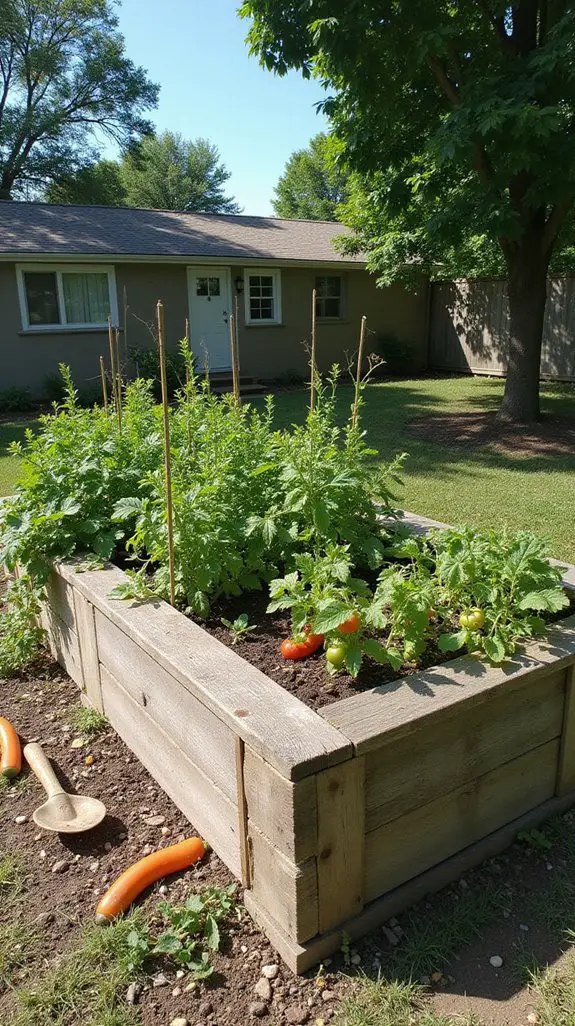
Transforming scrap wood into a raised garden bed offers an economical and effective way to enhance any gardening space. By utilizing leftover wood from previous projects, gardeners can create an elevated structure that improves soil quality and drainage. This design not only keeps pests at bay but also adds visual appeal to the garden landscape. Additionally, using a metal raised bed kit can provide a more durable option for those looking for long-lasting solutions. Building a raised bed is a sustainable practice, encouraging the upcycle of materials while providing a dedicated area for growing vegetables, herbs, or flowers. Incorporating raised bed corner brackets further strengthens the corners of the garden bed, enhancing its overall stability. Furthermore, utilizing a steel garden wheelbarrow can significantly ease the transportation of soil and plants, making the gardening process more efficient. Additionally, incorporating a soil blocking tool can further optimize the planting process by promoting healthy seedling development. It fosters a productive environment and offers an accessible gardening solution for individuals seeking to beautify their outdoor areas without significant costs.
Use Old Tires as Colorful Planters
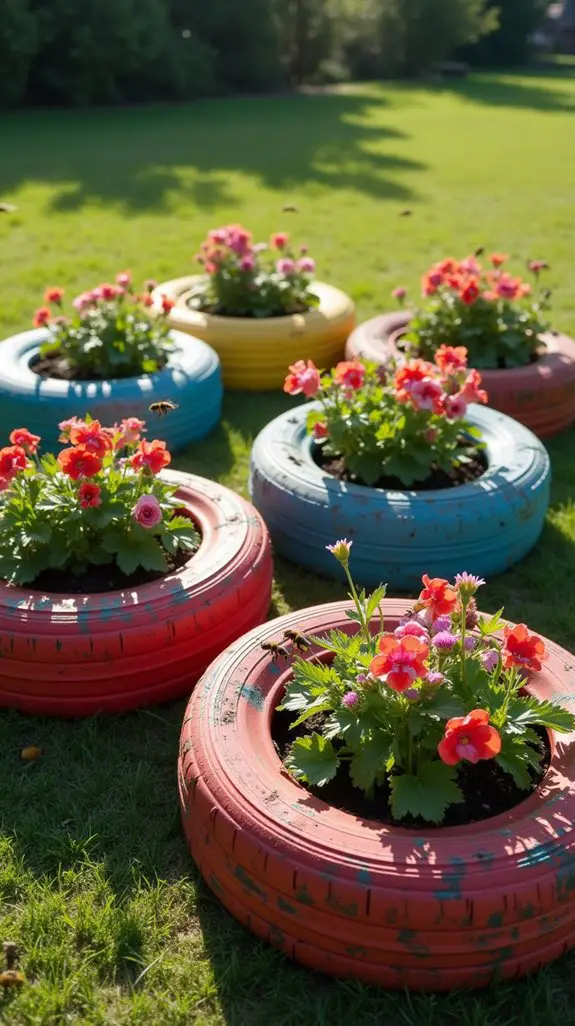
While many gardeners seek to add unique touches to their outdoor spaces, old tires can serve as an inventive solution for colorful planters.
By transforming discarded tires into vibrant flower pots, individuals can integrate sustainability and artistry into their gardens. Painting tires in bright colors not only enhances the visual appeal but also allows for personalization to match existing themes.
These quirky planters can accommodate various plants, adding charm and character to any yard. This approach is not only budget-friendly but also encourages creative recycling, making it a popular choice among environmentally conscious gardening enthusiasts.
Create a Small Pond Using a Large Bucket or Basin
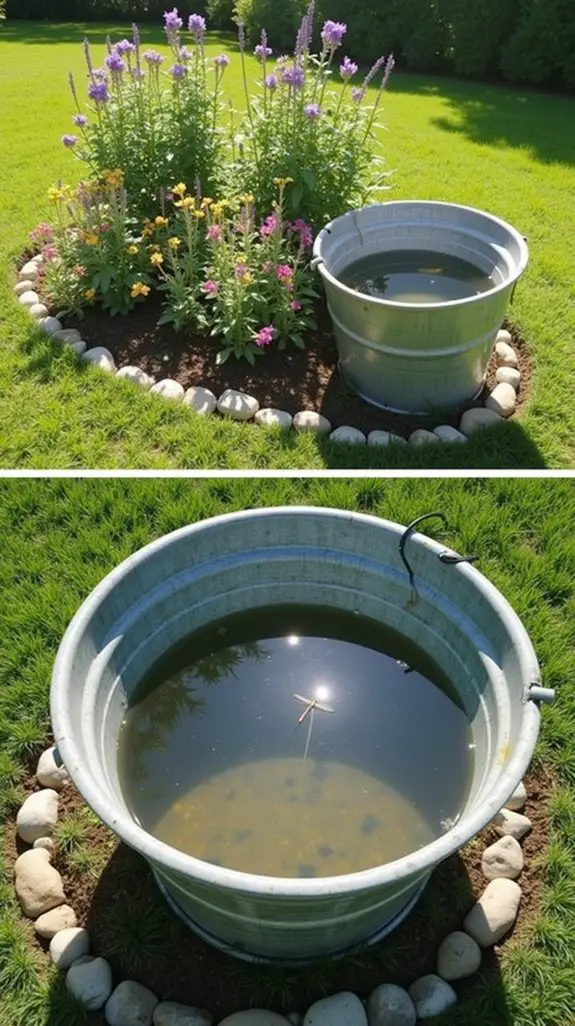
Old tires can add vibrant charm to gardens, and similarly, a large bucket or basin can be repurposed into a serene small pond.
This DIY approach introduces tranquility to outdoor spaces without a hefty price tag. By filling the bucket with water and adding aquatic plants, stones, or even small fish, gardeners can create a focal point that enhances biodiversity.
The process is straightforward and encourages creativity, making it accessible for anyone. Furthermore, the pond can attract beneficial wildlife, enriching the garden’s ecosystem.
This budget-friendly water feature transforms a simple yard into a peaceful retreat.
Make Stepping Stones From Cement and Molds
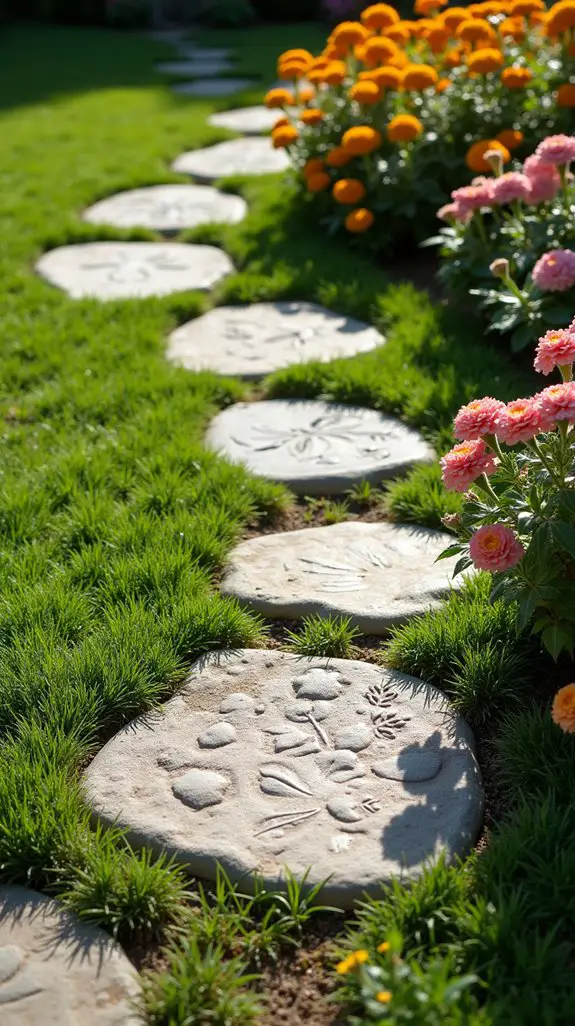
Creating personalized stepping stones with cement and molds adds a unique touch to any garden pathway. This budget-friendly DIY project allows gardeners to express their creativity while enhancing outdoor aesthetics. By utilizing various molds, individuals can craft stones in different shapes and sizes, tailoring designs to their preferences. Additionally, investing in a garden stepping stones set can provide inspiration for creative designs. Using proper bonsai pruning tools can also help keep surrounding plants in check while you work on your stepping stones. An efficient garden tool rack can further streamline your gardening tasks by keeping your tools organized and easily accessible. Mixing cement is straightforward, and adding decorative elements like pebbles or leaves can elevate the overall look. Once set, these stones provide functional walkways, improving accessibility in the garden.
Use Wine Bottles for Garden Edging
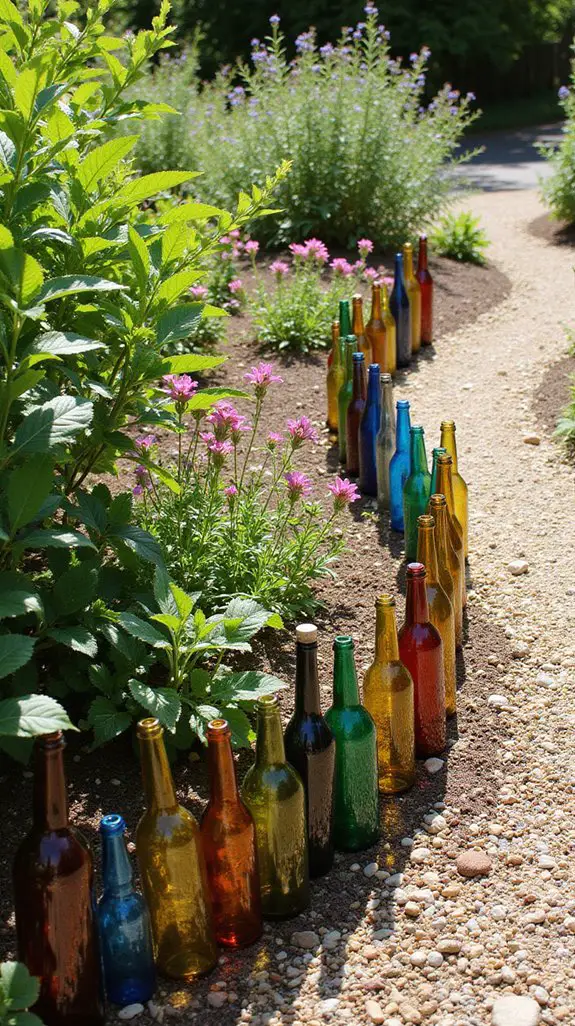
One innovative way to enhance garden aesthetics is by using empty wine bottles as garden edging.
This eco-friendly method involves burying the bottles neck-down along garden beds or pathways, creating a distinctive border that delineates different areas. Wine bottles come in various colors and shapes, allowing for unique design elements that catch the eye. Additionally, incorporating a wood garden bench nearby can provide a functional spot to relax and enjoy your beautifully edged garden. You can further elevate the look of your outdoor space by using stylish ceramic planters that complement the vibrant colors of the wine bottles. Utilizing compact pruning shears can help maintain the shrubs and plants near your new edging for a tidy appearance. Not only does this approach repurpose materials that would otherwise go to waste, but it also provides a cost-effective solution for landscaping. Moreover, incorporating decorative elements such as bonsai wire sets can further enhance the overall visual appeal of your garden.
Ultimately, using wine bottles for garden edging introduces a creative touch while promoting sustainability in outdoor spaces.
Hang Plants With Macramé or Upcycled Hangers
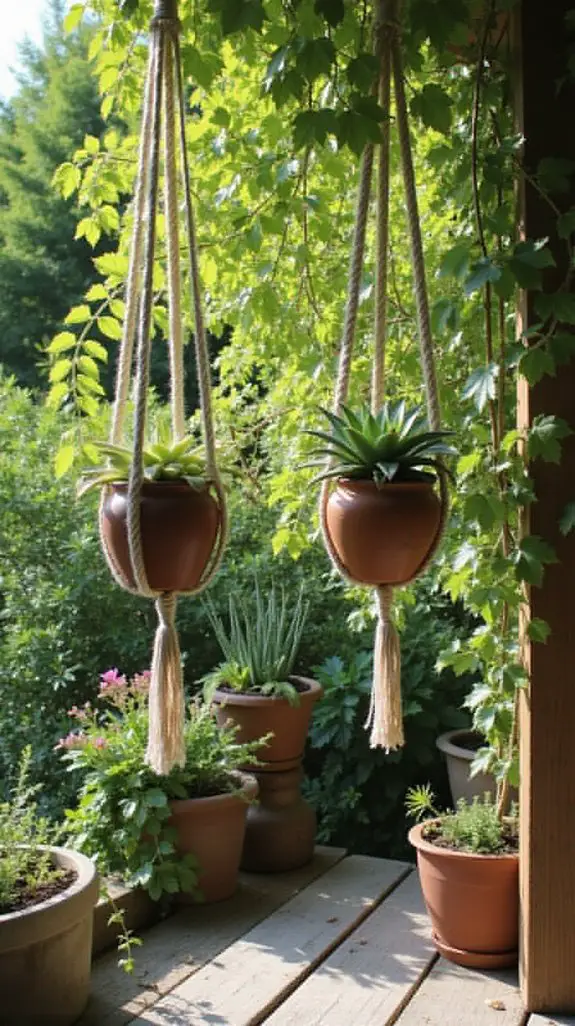
A plethora of gardeners are discovering the charm of hanging plants with macramé or upcycled hangers, which adds a vertical element to their outdoor spaces. Additionally, incorporating a vertical garden wall planter can further enhance the greenery by creating an elevated and visually captivating display.
These decorative hangers not only save space but also infuse a bohemian vibe that enhances the garden’s aesthetic. Creating macramé hangers or upcycling materials like old belts or fabric strips allows for personal expression while being budget-friendly. A great way to complement this would be to include an air plant terrarium kit, which offers a unique and low-maintenance addition to your hanging displays. Opting for a macrame plant hangers set can provide a cohesive look for your collection.
Ideal for small patios or balconies, these stylish plant displays invite greenery at varying heights, transforming any area into a lively sanctuary. Incorporating creative wall planter pockets into your hanging plant display further maximizes your gardening potential.
This approach encourages creativity and sustainability in gardening, turning ordinary spaces into extraordinary retreats.
Make a Trellis With Bamboo or Sticks
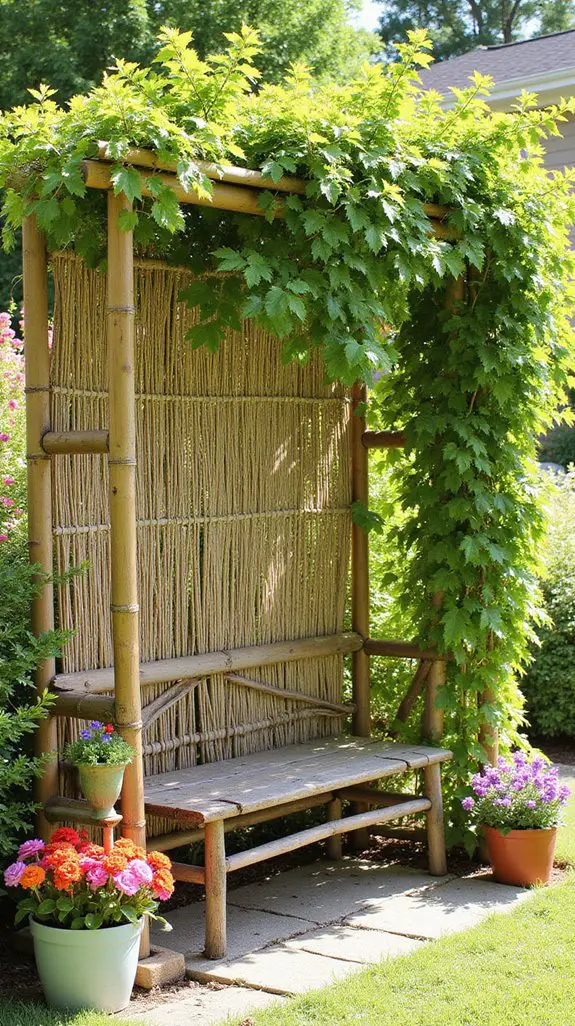
Constructing a trellis with bamboo or sticks offers a cost-effective and natural solution for supporting climbing plants in the garden.
This simple DIY project allows gardeners to enhance vertical growth, providing essential support for plants like beans and cucumbers. Utilizing readily available materials, such as bamboo poles from local sources or sticks gathered from the yard, guarantees minimal expense and environmental impact.
A well-designed trellis also adds structure and visual interest to outdoor spaces, allowing for creativity in its shape and size. By incorporating this sustainable gardening technique, one can effectively beautify their yard while cultivating healthy plants. Additionally, using wood lattice fence panels can further enhance the trellis’ stability and aesthetic appeal.
Decorate Pots With Paint or Mosaics
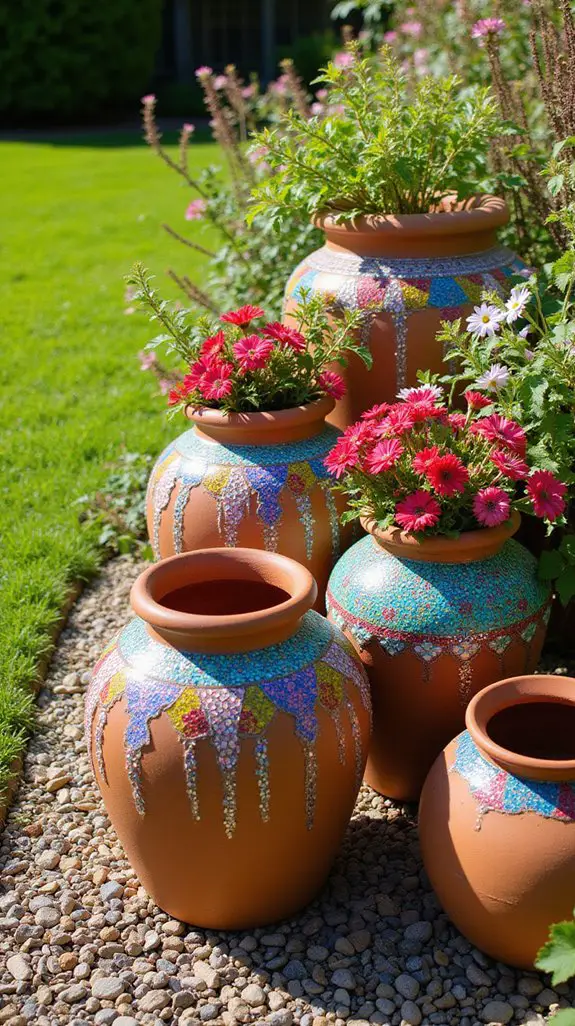
Transforming plain gardening pots with vibrant paint or intricate mosaics can greatly enhance the overall aesthetic of any outdoor space. By using creative techniques, individuals can add personality and charm to their gardens without breaking the bank. Paint allows for endless customization, enabling gardeners to match their pots with their chosen color scheme or seasonal themes. Additionally, using an electric string trimmer can help maintain the garden’s tidy appearance by keeping grass and weeds in check. Adding a classic touch with classic garden gnomes can also create a whimsical atmosphere in the garden.
Meanwhile, mosaics add texture and visual interest, showcasing artistic flair. This budget-friendly approach not only revitalizes old pots but also encourages self-expression, making each piece a unique focal point in the garden. Incorporating hanging flower planters can further elevate the garden’s design, creating a stunning vertical display of blooms. For added convenience, consider using self-watering pots indoor which help maintain optimal moisture levels for your plants. Ultimately, beautifying the yard with minimal expense is achievable through these creative enhancements.
Create a Compost Bin From Pallets
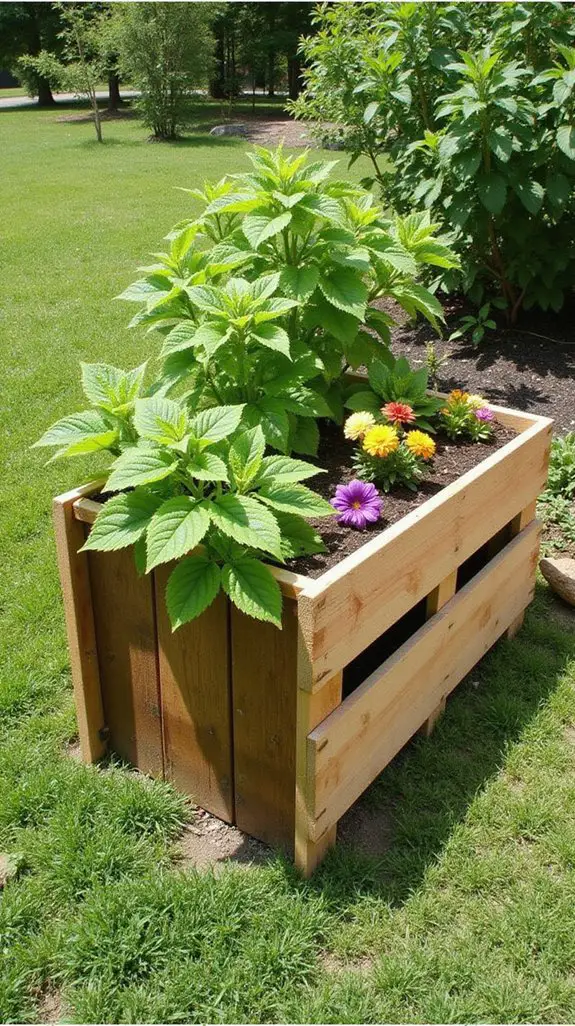
Repurposing old pallets into a compost bin offers a practical solution for managing kitchen and garden waste while enhancing soil quality.
By assembling pallets into a rectangular frame, gardeners create an efficient space for composting organic materials. The slats of the pallets provide airflow, essential for decomposition, and allow easy access for mixing.
This budget-friendly project not only promotes sustainability by recycling unused materials but also contributes to producing nutrient-rich compost for gardens.
Additionally, the compost bin can be customized in size and design, fitting various garden aesthetics while being a functional addition to any yard.
Use Broken Pottery for Drainage or Decoration
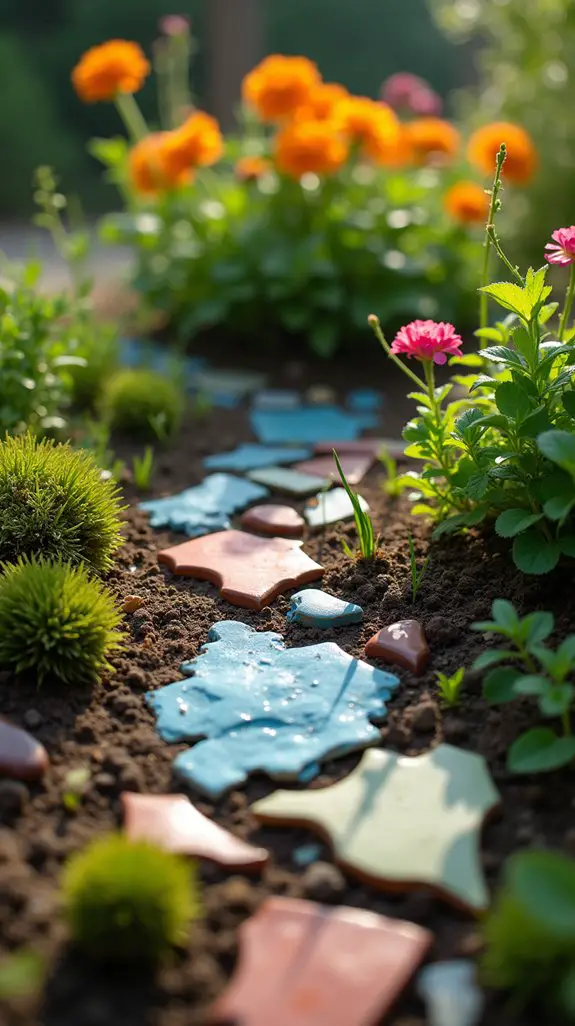
A wealth of creativity can be found in using broken pottery for both drainage and decorative purposes in gardens. When pottery shatters, the pieces can be repurposed as effective drainage material at the bottom of pots, ensuring excess water flows away from plant roots. Furthermore, using a foam kneeling pad can add comfort while gardening, allowing you to work longer without discomfort.
Additionally, fragments can serve as visually appealing ground cover or mulch, adding texture and color to garden beds. This method not only prevents waste but also enhances the garden’s aesthetic appeal. Using a garden apron with pockets while handling and arranging these materials can make the task easier and more organized.
Design a Seating Area With Repurposed Furniture
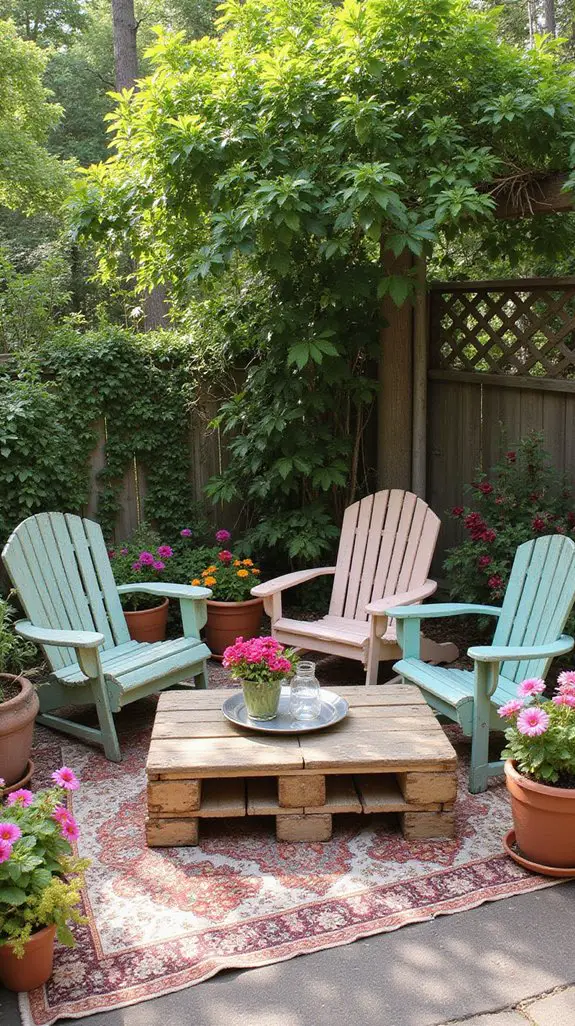
How can one create a charming seating area in the garden while sticking to a budget?
Designing an inviting outdoor space can be effortlessly achieved by refurbishing old furniture. By updating neglected chairs, benches, or tables with fresh paint or weather-resistant cushions, they transform into cozy retreats for relaxation. This approach not only enhances aesthetic appeal but also promotes sustainability by repurposing items that may otherwise be discarded.
Incorporating various styles and colors can create a playful atmosphere, while maintaining affordability. Ultimately, a creative seating area invites one to enjoy nature and fosters a welcoming environment for family and friends.
Conclusion
In summary, transforming your yard into a beautiful sanctuary doesn’t have to be costly. By incorporating these budget-friendly garden ideas, individuals can evoke their creativity while using recycled and repurposed materials. From DIY vertical gardens and charming planters to quirky decorations and inviting seating areas, the options are endless. Embracing these simple projects not only uplifts the outdoor space but also fosters a sense of accomplishment and connection to nature, making gardening accessible to all.

